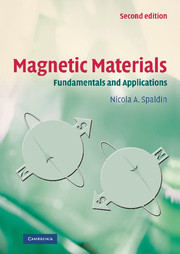Book contents
- Frontmatter
- Contents
- Acknowledgments
- I Basics
- 1 Review of basic magnetostatics
- 2 Magnetization and magnetic materials
- 3 Atomic origins of magnetism
- 4 Diamagnetism
- 5 Paramagnetism
- 6 Interactions in ferromagnetic materials
- 7 Ferromagnetic domains
- 8 Antiferromagnetism
- 9 Ferrimagnetism
- 10 Summary of basics
- II Magnetic phenomena
- III Device applications and novel materials
- Epilogue
- Solutions to selected exercises
- References
- Index
5 - Paramagnetism
from I - Basics
Published online by Cambridge University Press: 05 June 2012
- Frontmatter
- Contents
- Acknowledgments
- I Basics
- 1 Review of basic magnetostatics
- 2 Magnetization and magnetic materials
- 3 Atomic origins of magnetism
- 4 Diamagnetism
- 5 Paramagnetism
- 6 Interactions in ferromagnetic materials
- 7 Ferromagnetic domains
- 8 Antiferromagnetism
- 9 Ferrimagnetism
- 10 Summary of basics
- II Magnetic phenomena
- III Device applications and novel materials
- Epilogue
- Solutions to selected exercises
- References
- Index
Summary
A grocer is attracted to his business by a magnetic force as great as the repulsion which renders it odious to artists.
Honoré De Balzac, Les Célibataires, 1841In the previous chapter we discussed the diamagnetic effect, which is observed in all materials, even those in which the constituent atoms or molecules have no permanent magnetic moment. Next we are going to discuss the phenomenon of paramagnetism, which occurs in materials that have net magnetic moments. In paramagnetic materials these magnetic moments are only weakly coupled to each other, and so thermal energy causes random alignment of the magnetic moments, as shown in Fig. 5.1(a). When a magnetic field is applied, the moments start to align, but only a small fraction of them are deflected into the field direction for all practical field strengths. This is illustrated in Fig. 5.1(b).
Many salts of transition elements are paramagnetic. In transition-metal salts, each transition-metal cation has a magnetic moment resulting from its partially filled d shell, and the anions ensure spatial separation between cations. Therefore the interactions between the magnetic moments on neighboring cations are weak. The rare-earth salts also tend to be paramagnetic. In this case the magnetic moment is caused by highly localized f electrons, which do not overlap with f electrons on adjacent ions. There are also some paramagnetic metals, such as aluminum, and some paramagnetic gases, such as oxygen, O2.
- Type
- Chapter
- Information
- Magnetic MaterialsFundamentals and Applications, pp. 48 - 64Publisher: Cambridge University PressPrint publication year: 2010
- 2
- Cited by



